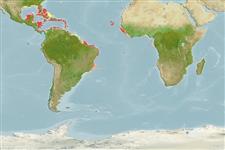Common names from other countries
>
Eupercaria/misc (Various families in series Eupercaria) >
Labridae (Wrasses)
Etymology: Doratonotus: Latin, deauratus = golden + Greek, noton = back (Ref. 45335).
More on author: Günther.
Environment: milieu / climate zone / depth range / distribution range
Ökologie
seewasser riff-verbunden; tiefenbereich 1 - 15 m (Ref. 9710). Tropical; 33°N - 29°S, 98°W - 10°E
Western Atlantic: Bermuda and southern Florida, USA to Brazil (Ref. 57756). Eastern Atlantic: Cape Verde Is, and São Tomé.
Size / Gewicht / Alter
Maturity: Lm ? range ? - ? cm
Max length : 9.4 cm TL Männchen/unbestimmt; (Ref. 9626); max. veröff. Gewicht: 10.80 g (Ref. 9626)
Rückenflossenstacheln (insgesamt) : 9; Rückenflossenweichstrahlen (insgesamt) : 10; Afterflossenstacheln: 3; Afterflossenweichstrahlen: 9. Color primarily grass green; usually some scattered small white or pale blue spots on head and body; small reddish brown spot near upper edge of caudal fin and another near lower edge (Ref. 13442).
Inhabits shallow beds of turtle grass (Thalassia). Common but seldom noticed (Ref. 9710).
Life cycle and mating behavior
Maturities | Fortpflanzung | Spawnings | Egg(s) | Fecundities | Larven
Oviparous, distinct pairing during breeding (Ref. 205).
Robins, C.R. and G.C. Ray, 1986. A field guide to Atlantic coast fishes of North America. Houghton Mifflin Company, Boston, U.S.A. 354 p. (Ref. 7251)
IUCN Rote Liste Status (Ref. 130435)
CITES (Ref. 128078)
Not Evaluated
Bedrohung für Menschen
Harmless
Nutzung durch Menschen
Fischereien: kommerziell; Aquarium: Kommerziell
Tools
Zusatzinformationen
Download XML
Internet Quellen
Estimates based on models
Preferred temperature (Ref.
115969): 26.1 - 28.2, mean 27.4 (based on 549 cells).
Phylogenetic diversity index (Ref.
82804): PD
50 = 1.0000 [Uniqueness, from 0.5 = low to 2.0 = high].
Bayesian length-weight: a=0.01096 (0.00644 - 0.01868), b=3.04 (2.89 - 3.19), in cm Total Length, based on LWR estimates for this species & (Sub)family-body (Ref.
93245).
Trophic level (Ref.
69278): 3.3 ±0.4 se; based on size and trophs of closest relatives
Widerstandsfähigkeit (Ref.
120179): hoch, Verdopplung der Population dauert weniger als 15 Monate. (Preliminary K or Fecundity.).
Fishing Vulnerability (Ref.
59153): Low vulnerability (10 of 100).
